Phnom Penh Travel Guide
According to legend, an old woman named Penh founded the city of Phnom Penh when she discovered four Buddha images on the Mekong River's banks. She placed the items on a nearby hill and a town grew around them, becoming known as the Hill of Penh (Phnom Penh).
Sometime later, during its prime, Phnom Penh had a claim to being the loveliest of Indochina's French-built cities. Today, it sprawls at the junction of the Mekong and Tonlé Sap Rivers. Its colonial charm contrasts with its heavy traffic and modern concrete buildings, with visitors enjoying its old French villas, street-side cafes, tree-lined boulevards and majestic Khmer buildings.
Phnom Penh's wats (temples) and museums also make for interesting adventures. Many visitors find time for sunset cruises on the Mekong and Tonlé Sap Rivers, and shopping at a bustling marketplace. Otherwise, the city's nightlife has a solid reputation, as does its food and café culture.
Things to do in Phnom Penh
Phnom Penh is very much a two-day city, with plenty to experience in a short time, but little to keep visitors for longer. The Royal Palace and National Museum are worth a morning to get a sense of the country's rich heritage. As a counterpoint, a trip to the Tuol Sleng Museum and Killing Fields will reveal the terrible atrocities Pol Pot's reign of terror wreaked on the Khmer people.
In a lighter vein, visitors can shop in the lively Central and Russian Markets, enjoy a fun nightlife, or simply watch the sun set over the river. Travel itineraries should also include some of the activities on offer. River cruises are a must, as are trips to the famous shooting ranges, where guests can try out heavy weaponry. Cooking classes are popular as well. Otherwise, Phnom Penh lends itself to leisurely hours on the riverbanks, soaking up the cafe culture and watching the world go by.
Travellers looking to explore the region a little more can head to Sihanoukville's gorgeous beaches, unwind in the resort town of Krong Kep, or see the Mekong's Irrawaddy river dolphins.
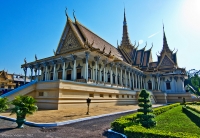
The Royal Palace
The Royal Palace is one of the principal attractions of Phnom Penh and contains the best examples of 20th-century Khmer architecture in the city. It has remained the official residence of the kings of Cambodia since 1860. Set among the perfectly manicured gardens are the exquisite Throne Hall, the Elephant Pavilion, the Royal Treasury and the Chan Chhaya Pavilion, built especially for performances of classical Cambodian dance.
Although much of the palace is off-limits, the Silver Pagoda with its floor of silver tiles is open to visitors. The internal walls are decorated with frescoes depicting episodes of the Ramayana myth, painted in 1903 by 40 Khmer artists. It is also called the Pagoda of the Emerald Buddha, a tribute to the magnificent baccarat crystal image of the Emerald Buddha that sits in the centre.
There are other intricately carved Buddha images on display, notably the life-size solid gold statue that stands in front of the pedestal, decorated with 9,584 diamonds. Visitors should remember to dress conservatively and respectfully when visiting the Royal Palace; bare shoulders or legs are frowned upon within the complex.
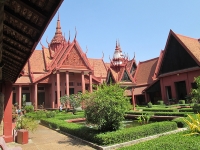
National Museum
The National Museum is a striking and famous example of the Khmer architectural tradition and houses the country's most important collection of ancient Cambodian cultural material and art. It is made up of four galleries containing relics, sculpture, art and tools covering history from the prehistoric, the pre-Angkorian, the Angkorian and the post-Angkorian periods of Cambodian culture. Arranged in chronological order the already impressive collection continues to grow as new treasures previously hidden from the Khmer Rouge are discovered. Guided tours in English and French cost a bit extra but they are worthwhile as the printed information in the museum is minimal. Photography is not allowed inside the building.
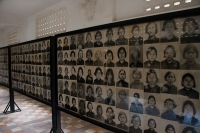
Tuol Sleng Museum
When the Khmer Rouge came into power in 1975, they commandeered and converted a secondary school into a primitive prison where they detained and tortured anyone suspected of anti-revolutionary behaviour. Between 1975 and 1979, an estimated 20,000 victims were imprisoned in Security Prison 21, or S21 as it was known. The building appears almost exactly as the fleeing Khmer Rouge left it, serving as a testimony to the crimes and atrocities of the organisation.
It is a tremendously moving and sombre experience, the museum's photographs, instruments of torture and bloodstained walls giving an idea as to the pain and horror borne by the Cambodian people. Thousands of victims were transported from here to the extermination camp outside the city, Choeung Ek (The Killing Fields). There are some first person accounts on display at the museum, despite the fact that, of the estimated 20,000 prisoners incarcerated in S21, there are only 12 known survivors.
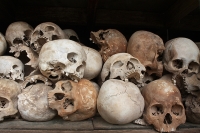
Choeung Ek (The Killing Fields)
The Cambodian genocide during the late 1970s ranks as one of the great horrors of modern history. Under Pol Pot, an estimated 1.7 million people were either ruthlessly slaughtered by the Khmer Rouge, or died of starvation in the communal fields. Choeung Ek was the extermination camp where the prisoners from S21 (now the Tuol Sleng Museum) were executed. Also known as the Killing Fields, after the movie of the same name, this football-field-sized area contains the mass graves of about 20,000 people.
A tall Memorial Stupa has been constructed to commemorate the dead with more than 8,000 human skulls displayed behind the glass. At the entrance, a handwritten sign in Khmer and English summarises the atrocities perpetrated by the Khmer Rouge. As a reminder of the reality of this great tragedy, human bones are still frequently unearthed by heavy rains in the area, and many of the tour guides have personal stories to tell about their experiences during Pol Pot's reign. A visit to the Killing Fields is harrowing and perhaps not suitable for children, but remains one of the most popular tourist attractions in Cambodia.
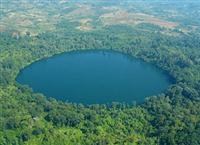
Ratanakiri
The slightly inaccessible Ratanakiri Province sits along the border with Vietnam. Visitors to the area enjoy exploring its stunning natural beauty of lush tropical rainforests, volcanic lakes and pristine waterfalls, along with abundant wildlife such as Asian elephants, monkeys, guar and a kaleidoscope of endangered and exotic birds.
One of the key tourist attractions is Yak Loum, a perfectly round crater lake with crystal-clear waters, surrounded by dense jungle foliage. The lake is great to swim in and a relatively short distance from the town of Banlung. Also close by is the lovely Lomphat Wildlife Sanctuary, which is also home to number of endangered species including banteng, tiger, dholes and sun bear, as well as leopards, Eld's deer, sambar deer, muntjacs and wild pigs
Ratanakiri is cooler than most of the country and a favourite among eco-tourists. But visitors should be aware that roads in the region aren't great, turning very muddy during the wet season and covered in thick red dust during the dry season. Boats serve as popular alternative modes of transport for scenic trips.
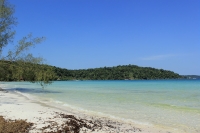
Sihanoukville
While this beach town isn't nearly as famous as those found along Thailand's pristine coast, it does make a great tourist getaway. Sihanoukville is the country's only deep water port, making much of the town industrial and unattractive to tourists. But the coastal city is surrounded on three sides by the Bay of Thailand and there are several secluded tourist beaches with all the requisite trappings: dishevelled beach bars, guesthouses, and smiling hawkers. As there isn't much to do in town, it is worth the extra money to stay in the quaint beachside accommodation.
Daytime activities include swimming, fishing, snorkelling, scuba diving, and boat trips to the nearby islands. There are also several Buddhist temples to be explored in the area and the Ream National Park is only 11 miles (18km) away. Most hotels and guest houses offer transport and day passes for visiting the National Park. Nightly beach barbecues prepare great food and offer cheap beer. The government is said to have plans to develop the area for larger resorts which may well ruin its laid-back beach charm in years to come. Regular daily buses provide a three to four hour journey to and from Phnom Penh, along Cambodia's best road. There is also a ferry connecting to Koh Kong, the Cambodian/Thailand border.
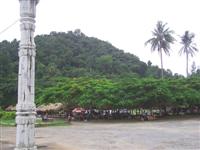
Krong Kep
From Phnom Penh, a great excursion is the formerly lavish resort town of Krong Kep. Once a famous high-society destination called The Pearl of the Orient, Kep is now more of a rustic off-the-beaten-track fishing village. The Khmer Rouge wreaked havoc on the town, but the ruined villas of the rich now add to Kep's crumbling mystique. A beautiful coastal road, beautiful beaches, jungled mountains and the nearby Rabbit Island ensure that Krong Kep continues to draw visitors to its shores.
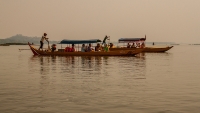
River Dolphins
The Irrawaddy river dolphins inhabit a 118-mile (190km) stretch of the Mekong River. These odd but delightful creatures are in danger of extinction, with recent population estimates as little as 85, but are fortunately now protected. They are sometimes spotted from the riverbank but many tourists opt to rent small boats to get closer to them. The local oarsmen retain a healthy distance from surfacing animals but viewers can get close enough to recognise individual characteristics and see the famous dolphin smiles.
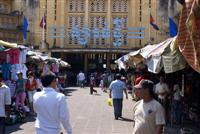
Central Market (Psah Thmey)
A trip to Phnom Penh would be incomplete without a visit to Central Market and its quirky architecture. This famous Art Deco building consists of a huge central dome with four wings spilling out into large halls. Psah Thmey contains countless stalls run by more than 3,000 merchants. When the market was first opened in 1937, it was said to be the biggest market in Asia. Visitors can buy almost everything here (make sure to haggle), including souvenirs, clothes, fresh produce, books, flowers, postcards, antiques and a vast selection of jewellery. Its central location is walkable from almost anywhere and is a recognisable landmark from many of Phnom Penh's main roads.
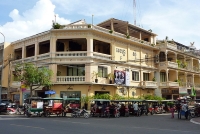
Foreign Correspondents Club
A pleasant way to spend the evening in Phnom Penh is on the wide balcony of the Foreign Correspondents Club. It sits on the banks of the riverside overlooking the converging Mekong and Tonle Sap, with spectacular views best appreciated at sunset. The FCC can be more expensive than its neighbours, but the colonial-chic style and atmosphere of the place lends a certain French flair to the experience. The club is one of Southeast Asia's most legendary watering holes, famous for being the meeting place of numerous journalists who covered the last days of Pol Pot's regime.
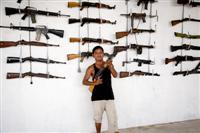
Shooting Ranges
Amuse your inner warrior with one of Phnom Penh's best carnal pleasures: shooting big guns. Whatever one's taste, be it automatic rifles, rocket launchers, or grenades, they are on offer. The city is known for availability of weapon that are probably deemed unsuitable at home. There are about four well-known shooting ranges in Phnom Penh that are generally run by the military. While there are safety measures in place, it is a remarkably casual and free environment. This comes at a cost, at more than a dollar a bullet, ensuring that Rambo instincts are kept in check.
Upon arrival you should be able to see all the weapons on display and read a 'menu' detailing what is available and how much handling each weapon costs. Guides generally recommend that you visit the shooting range first if you plan to also see sites like the Killing Fields, as experiencing Cambodia's violent past has been known to dampen the excitement and fun to be had at the range. Most guesthouses and taxi drivers can recommend a good shooting range, but it is best to check online reviews to ensure you are going to a respected establishment. The Cambodia Extreme Outdoor Shooting Range is a favourite with travellers and has been awarded certificates of excellence by review sites like TripAdvisor in recent years.
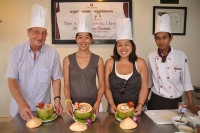
Cambodia Cooking Class
Cambodian cooking classes are one of Phnom Penh's most popular tourist attractions. Khmer cuisine distinguishes itself from Thai and Vietnamese cooking through delicate use of spices and aromatic herbs, creating finely-balanced flavours that run a gamut of sweet, salty, sour and spicy. Frizz Restaurant in downtown Phnom Penh prides itself on 'small classes, maximum attention', and space is limited to 16 participants per day. During the full-day lesson visitors will learn to prepare a full-course Khmer meal, and get some useful tips about the blending of spices and the decorative aspects of Cambodian cuisine. Included in the price are transportation to and from the restaurant, a visit to the market to buy ingredients and a full-colour recipe booklet.
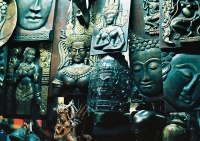
Russian Market
Not to be confused with the Central Market (Psah Thmay), the Russian Market (Psar Toul Tom Poung) is located south of Mao Tse Toung Boulevard. It's home to a huge mishmash of treasures, such as silk scarves and hammocks, motorcycle parts and curios, as well as souvenirs, jewellery and custom tailors. The market is also a wonderful spot for sampling local food, the fish soup particularly popular. It can get rather crowded and, combined with the midday heat making it unbearably hot inside, it can be a little overwhelming so it's best to go early or later in the evening. Visitors in need of a reprieve from the heat can head to one of the nearby cafés lining the market for a refreshing fruit cocktail.
Eating Out
Phnom Penh has a great variety of restaurants, ranging from local cuisine to a burgeoning selection of international menus. Generally speaking, eating out in Cambodia isn't too expensive. The main restaurant areas are Street 51, the Riverfront, and the Wat Phnom area (particularly Street 104). Food sections in markets or roadside food carts are decent alternatives to restaurants, especially for simple Cambodian variations of fried chicken and the like.
Regarding Khmer (Cambodian) cuisine, fare such as Prahok, (pungent, fermented fish paste) can challenging for foreign palates. That said, some local dishes are accessible. The most beloved of these is Cambodia's national dish. Called Fish Amok, it involves coconut milk, chilies, onion, and spinach, all served with rice in banana leaves. For the more adventurous, Khmer staples like deep-fried tarantulas and red tree ants are a must.
Cambodia's French-colonial history comes through in things like baguettes and frog's legs.
Getting Around
The city is relatively small and is easy to negotiate on foot. Walking in the midday heat can be uncomfortable, though.
For safety reasons, visitors should be aware at all times. More specifically, they should try not to display conspicuous wealth or walk alone at night, as bag snatching is a problem.
Unmetered taxis can usually be arranged through hotels. Bicycle rickshaws (cylos) are widely used, but are best for short distances. Tuk-tuks (motorbikes with small cabins attached to the rear) may be the best option for tourists. That is, English-speaking Tuk-tuk drivers can double as city guides. Passengers should negotiate fares beforehand.
Phnom Penh's public buses are slower than the other forms of transport on offer. Still, they remove the threat of bag or phone snatching, passengers don't need to negotiate prices, and they're cheap.
Renting a car may be unwise, given that roads and traffic are bad.
Phnom Penh Climate and Weather
Phnom Penh's climate can be described as tropical, with hot weather all year round and seasonal monsoons. There are two distinct seasons: rainy and dry. Temperatures during the rainy season (June to October), average between 81°F (27°C) and 93°F (34°C). The dry season (November to March) is characterised by cool months, with temperatures averaging between 70°F (21°C) and 90°F (32°C), and hot months (March to May), which see temperatures range between 81°F (27°C) and 95°F (35°C).
Winter is the best time to visit Phnom Penh, when the weather is cooler and activities will not be disrupted by rain showers. Roads are also better in the dry season, as they're not muddy.
Cambodia travel info
Electricity
Local electrical current is 230 volts, 50Hz. The European round two-pin plug is standard. Travellers should be aware that power cuts are frequent and, outside the capital, electricity is generally only available in the evenings.
Language
Khmer is the official language. French is also spoken, but English is fast becoming popular with the younger generation.
Money
Riel (KHR) is the official currency and is divided into 100 sen. Foreign currency can be difficult to exchange, with the exception of US Dollars. Most transactions require cash but credit card use is on the rise, especially in tourist-orientated hotels and restaurants in larger cities and towns. US Dollars and Thai Baht are accepted, although smaller transactions are usually done in Riel. A torn US Dollar note is useless. There are ATMs in Phnom Penh, Siem Reap, and Sihanoukville but they shouldn't be relied upon as a source of money.
Tipping
Tips are not necessarily expected, but are welcomed in restaurants and hotels. Hotels often add a 10 percent service charge to the bill, but small amounts for personal services are appreciated, as salaries in the country are low. Tour guides should be tipped.
Health
Malaria is common in Cambodia and malaria prophylaxis is recommended for all areas except Phnom Penh and around Lake Tonle Sap. Dengue fever, transmitted by mosquitoes, is also prevalent, especially in the heavily populated areas. Insect protection measures should be taken throughout the day. Travellers staying long-term, or for more than one month, and those who may engage in extensive outdoor activities, should be vaccinated against Japanese encephalitis. Vaccinations for hepatitis A, hepatitis B and typhoid are recommended for all travellers. If you come from a yellow-fever-infected area then a yellow fever vaccination is required. Avoid swimming or paddling in fresh water as Bilharzia is present. Tap water is not suitable for drinking but bottled water is widely available. Avoid uncooked meat, unpeeled fruit, salads and food sold by street vendors, and don't drink beverages containing ice. Medical facilities are very limited in most of Cambodia, except for a few expensive private clinics in Phnom Penh. Treatment must be paid for with cash and health insurance is essential.
Safety
Cambodia remains one of the most heavily land-mined countries in the world. When hiking or visiting rural areas, travel with a local guide and never stray off the main paths. It is not advisable to travel in rural areas at night.
Caution should be taken in the capital, Phnom Penh, especially at night, as street crime is a problem, and popular tourist nightspots may be targeted. After dark there is also a risk of crime in Siem Reap and Sihanoukville. Visitors should be aware that bag snatching is becoming an increasing problem on tuk-tuks, motorcycle taxis, and while walking in the main towns. Due to the large numbers of tourists involved in road accidents on motorcycles, police in Siem Reap and other tourist centres have in the past banned rental outlets from hiring motorcycles to tourists - these bans are sporadic and may happen at any time.
There is political tension, tourists should avoid large gatherings, demonstrations, and political meetings. Travellers are also advised to avoid the Cambodian-Thai border areas because of ongoing border disputes; the Preah Vihear temple area has become particularly dangerous.
Local customs
Permission should be sought before taking pictures of people, particularly monks. Avoid touching someone on the head as it is considered the most sacred part of a person's body. When visiting religious sites, shoes should be removed, and shorts avoided; women in particular should dress modestly. A traditional greeting in Cambodia is a bow, bringing together the hands at chest level (similar to hand position for prayer). With foreigners Cambodians sometimes convert to the handshake. The simple rule is to respond with the same greeting you were given.
Doing business
Developing a personal relationship in Cambodia is important before any business can be discussed, a process which might include shared meals and plenty of socialising. It is considered rude to cause any business associate to 'lose face' publically, so tact and politeness are important.
On introduction, the most senior in the group will be introduced first, and visitors are advised to do likewise so that the hosts understand the hierarchy of the group; the highest-ranking person on both sides should greet each other first and perform the introductions. A light handshake is appropriate on introduction, after which business cards can be exchanged using both hands; it is considered impolite to put the card away without making a show of studying it for a short while. If men are dealing with women they should wait and see if they extend a hand before doing so. Eye contact should be kept to a minimum.
In Cambodia people are addressed with the honorific title 'Lok' for a man and 'Lok Srey' for a woman followed with the first name or both the first and surname. Dress is conservative, but formal business suits will be out of place in the tropical heat; lightweight suits can be worn for formal meetings. Business hours are generally 8am to 5pm Monday to Friday, often with a long lunch from about 12pm till 2pm.
Duty free
Travellers to Cambodia are allowed to enter the country with a reasonable amount of tobacco products and spirits for personal use: 200 cigarettes or 50 cigars or 200g of tobacco; about 350ml of perfume; and two litres of alcohol. Cambodian customs authorities may enforce strict regulations on the import or export of drugs, firearms, antiquities, and ivory.
Communications
The international access code for Cambodia is +855. The outgoing code is 001 followed by the relevant country code (e.g. 00144 for the United Kingdom). Phnom Penh's area code is (0)23; the code for Siem Reap is (0)63. Internet cafes provide a fast and inexpensive service in Phnom Penh, Siem Reap, and other main towns. Free wifi is available at restaurants, cafes, and hotels in most tourist centred areas. Local prepaid SIM cards can be purchased for a reasonable price to avoid expensive international roaming fees.
Passport & Visa
All visitors must have sufficient funds to cover their stay and documentation for onward travel. A visa can be issued on arrival for 30 days. For a visa to be issued on arrival one passport photo is required and an empty page in the passport is required, along with US$30 for a tourist visa or US$35 for a business visa. E-visas can be obtained before departure at https://www.evisa.gov.kh/. Extensions of visas are usually possible.
Entry requirements
US travellers must have a passport valid for at least six months from date of arrival, and a visa, which can be obtained on arrival for stays of up to 30 days. Alternatively, US nationals can obtain an e-visa before departure at www.evisa.gov.kh
UK travellers must have a passport valid for at least six months from date of arrival, and a visa, which can be obtained on arrival for stays of up to 30 days. Alternatively a visa can be obtained online before departure at www.evisa.gov.kh
Canadian travellers must have a passport valid for at least six months from date of arrival, and a visa, which can be obtained on arrival for stays of up to 30 days. Alternatively, a visa can obtained online before departure at www.evisa.gov.kh
Australian travellers must have a passport valid for at least six months from date of arrival, and a visa, which can be obtained on arrival for stays of up to 30 days. Alternatively an e-visa can be obtained online before departure at /www.evisa.gov.kh
South African travellers must have a passport valid for at least six months from date of arrival, and a visa, which can be obtained on arrival for stays of up to 30 days. Alternatively visitors can obtain an e-visa online before departure from www.evisa.gov.kh
Irish travellers must have a passport valid for at least six months from date of arrival, and a visa, which can be obtained on arrival for stays of up to 30 days. Alternatively visitors can obtain an e-visa online before departure from www.evisa.gov.kh
New Zealand travellers must have a passport valid for at least six months from date of arrival, and a visa, which can be obtained on arrival for stays of up to 30 days. Alternatively visitors can obtain an e-visa online before departure from www.evisa.gov.kh
Useful contacts
Ministry of Tourism, Phnom Penh +855 (0)23 884 974 or www.tourismcambodia.org.
117 (Police), 119 (Ambulance), 118 (Fire)


